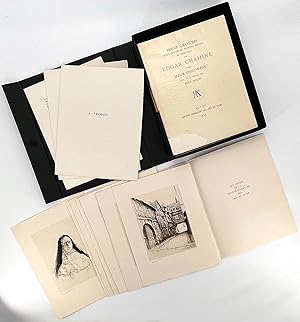Chahine Edgar Goncourt Edmond Et Jules (1 results)
Product Type
- All Product Types
- Books (1)
- Magazines & Periodicals
- Comics
- Sheet Music
- Art, Prints & Posters
- Photographs
- Maps
-
Manuscripts &
Paper Collectibles
Condition
- All Conditions
- New
- Used
Binding
- All Bindings
- Hardcover
- Softcover
Collectible Attributes
- First Edition
- Signed
- Dust Jacket
- Seller-Supplied Images
- Not Printed On Demand
Seller Location
Seller Rating
-
Soeur Philomène
Published by Société Normande des Amis du Livre, Rouen, 1934
Seller: Rob Zanger Rare Books LLC, Middletown, NY, U.S.A.
Condition: Fine. Dust Jacket Condition: Fine. Edgar Chahine (illustrator). Limited Edition. This special edition comprising a bound book, unbound "À Propos" by René Helot, and 36 etchings and drypoints by Edgar Chahine; 10 1/4 x 8 inches (260 x 203 mm), housed in a custom blue clamshell box (11 3/4 x 9 1/4 inches / 297 x 233 mm). * The book is printed in black and red on handmade paper, deckled edges: [2] 2, title, 172, limitation, 1, [3] pp.; Copy no. II of only 25 printed, this one printed for "Monsieur Georges Majoux, Vice-Président de la "Société Normande des Amis du Livre" as stated on the limitation page, signed in pencil by him * Unbound and uncut "À Propos" by René Helot, 24 pp, printed in black and red on thick wove paper. * Portfolio with two sets of 12 etchings and drypoints by Chahine, on thick wove paper, each sheet 10 3/8 x 7 7/8 in. (262 x 200 mm), housed within printed paper covers, with glassine overcover. Both sets are full-plate (approx. 8 1/2 x 6 1/4 in. each / 216 x 157 mm); one set with remarques. * Separate portfolio of 12 etchings and drypoints by Chahine in plain paper cover, printed on Arches paper, 6 with watermark, 6 without; each sheet 10 1/4 x 7 7/8 inches (260 x 200 mm), each plate 6 1/2 x 4 7/8 inches (165 x 124 mm), each signed in pencil on the left under the platemark. * ORIGINAL COPPERPLATE for the portrait engraving of Soeur Philomène, signed by Edgar Chahine and dated 1934 in the plate, measuring 6 5/8 x 4 7/8 in. (169 x 126 mm). [Carteret IV, 191; BNF32179763 ]. This extravagant grouping with 3 full sets of the 12 plates and one of the original copper plates, all signed by Chaine, was specially printed for Georges Majoux (1867 -1941), a leader in the French shipping and maritime trading, a keen bibliophile, and the VP of the Société Normande des Amis du Livre. It is the second of only 25 copies printed. EDGAR CHAHINE (1874-1947) was a French artist and engraver of Armenian descent who studied in Italy before moving to Paris. In 1900, his prints earned him a gold medal at the Universal Exhibition in Paris. He illustrated many books, beginning in 1905 with Anatole France's Histoire Comique, and for authors such as Flaubert, Verlaine, and the Goncourts. The GONCOURT BROTHERS, Edmond (1822-1896) and Jules (1830-1870) formed a formidable and unique team as writers, intellectuals and publishers, known for their naturalist style and their reactionary politics. They founded the Académie Goncourt, which has has awarded the Prix Goncourt since 1903, probably the most important literary prize in French literature. Their novel "Soeur Philomène," first published in 1861, is a dramatic tale of a nun working in a hospital. It originated from an anecdote told during a dinner at the home of Gustave Flaubert that made Jules and Edmond aware of the fate of a nurse from Rouen. For the description of the hospital environment the Goncourts did on-site research, approaching the subject as "historians of reality." Thanks to Flaubert's support, they were able to carry out a study "on the real, on the spot" at the Charité hospital [Journal, December 18, 1860]. While being part of a melodramatic tradition, Soeur Philomène is an innovative novel which highlights the medical function, even if, for fear of censorship, the Goncourts steered clear of blood-filled realism.


